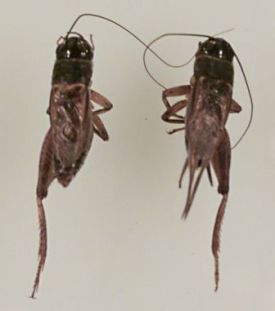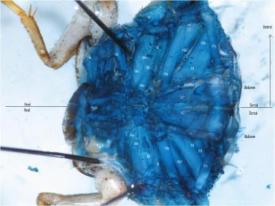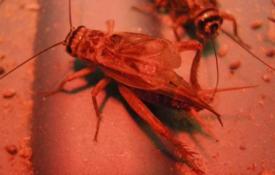
Acoustic Mating Behaviour Research
 Good-Genes vs Complementary-Genes:
Good-Genes vs Complementary-Genes:
Choosing a mate can be costly as it exposes the individuals to predators and takes time away from foraging. Given these costs, researchers have long wondered why strong mate preferences evolved in species where males provide nothing more to females then their sperm? The Hamilton-Zuk hypothesis suggests females are choosy because (1) fancy male traits will correlate with male health and (2) females mating with the fanciest males will have the healthiest offspring. While many researchers have shown support for the first part of this hypothesis, only a handful of studies have found support the second part of this hypothesis. Others have hypothesized that females gain a direct-fitness benefit for mating with fancy males: by associating with the fanciest of males, females avoid exposure to pathogens and parasites. Many data support the association between health and the expression of elaborate traits. However, this alternative hypothesis is silent about fitness benefits to offspring. We propose to test a recently introduced a third hypothesis for why females are choosy. Gowaty hypothesized that mate preferences are dependent on genetic differences in the complementarity of potential mates’ immune systems. Specifically, Gowaty’s complementary genes hypothesis suggests mating preferences “predict” offspring viability: when females mate with preferred males their offspring have higher viability. Gowaty’s hypothesis has only been tested in a handful of systems but all tests to date reveal strong support: choosy females have offspring with higher survival probabilities. These experiments have not, however, explored whether preferred mates were also the fancier ones. We propose to test whether offspring viability is significantly higher when choosers breed with preferred discriminatees AND whether preferred discriminatees are bigger, heavier, or fancier signalers. Our cricket study system allows us to characterize male cricket sexual signals in advance of the random mate choice tests, providing the first ever link of sexually selected traits to offspring viability variation
 Variation in Acoustic Mate Signalling:
Variation in Acoustic Mate Signalling:
Crickets vary extensively in the amount of effort they put into acoustically signalling to attract a mate. Some males signal for up to fourteen hours each night, but others signal for only a few hours, a few minutes, or not at all. Males also vary in how loud they signal, how long they signal without taking a break, and in how often they signal. My students and I explore the environmental and genetic underpinnings of this variation.
 Environmental Influences:
Environmental Influences:
We have quantified many environmental components influencing signalling effort. Signalling effort is not influenced by photoperiod, the presence of female crickets or parasitoid flies. Signalling effort is, however, correlated with flight capability, age, size, residual mass, development time, and diet quality. We are currently exploring how the social environment and diet underlie variation in fitness conferring behaviours. Our dietary research suggests that the needs of the organism and the relative scarcity of nutrients in nature may underlie variation in condition-dependent behaviours. Our social environment research is too new to discuss, but suggests social rearing environment, sex ratio at adulthood, and who is watching during fights can profoundly influence sexual behaviours.
 Trade-offs Among Acoustic Mate Signalling Components:
Trade-offs Among Acoustic Mate Signalling Components:
Given the conflicting selection pressures influencing acoustic signals, we are investigating whether male crickets made trade-offs among their multi-component acoustic signals to reduce their risk of becoming prey, or because of energetic, biomechanical, or physiological limitations.
 Electronic Acoustic Recording System:
Electronic Acoustic Recording System:
Females often prefer to mate with males that produce loud, long, and/or leading calls. However, because of time and personnel costs, only a handful of studies have quantified among-male variation in these temporal signalling parameters; even fewer studies have estimated the heritability of these traits. To alleviate this problem, we worked with Cambridge Electronic Designs to have an electronic acoustic recorder (EAR) built that can quantify the temporal components of up to 96 acoustically signalling insects simultaneously. Our EAR quantifies all aspects of signalling behavior, from when each male signals, to how much time he spends signalling, to how loud he signals, the duration of his signalling bouts, pulse duration, number of pulses per chirp, and all other fine-scale aspects of signalling.
 Acoustic Signalling and Quantitative Genetic Components:
Acoustic Signalling and Quantitative Genetic Components:
Some of our research explores the additive genetic and genotype by environment interactions influencing acoustic mate signalling behaviour. We estimated the heritability for total nightly signalling time in the Texas field cricket (Gryllus texensis). We reared cricket fathers, sons, and half-siblings and quantified their total nightly calling time. Signalling time appears to exhibit minimal heritability and little of the total variance appears to be additive genetic.
 Acoustically Orienting Parasitoids:
Acoustically Orienting Parasitoids:
Many animals use acoustic signals to attract mates but their signals simultaneously expose them to predators or parasites. Male Texas field crickets, for example, signal acoustically to attract potential mates but their calls also attract a parasitoid (Ormia ochracea; Tachinidae). These parasitoid females acoustically orient to signalling males and lay their larvae on and around the cricket. The larvae burrow inside to feed and grow. The parasitoid larvae emerges 7-10 days later, killing the host. Our research has revealed that males alter their calling behaviour after they are parasitized. Male acoustic mate signalling effort becomes greatly reduced in the late stage of parasitism.
 Behavioural Syndromes:
Behavioural Syndromes:
Behavioural syndromes are suites of correlated behaviours expressed either within a given behavioural context (e.g. mating) or between different contexts (e.g. foraging and mating). We investigated whether the field cricket Acheta domesticus exhibits behavioural syndromes. Specifically, we examined whether individuals display behavioural correlations across mating, activity, and anti-predatory contexts.
 Relationship Between Signalling, Allometry, and Physiology:
Relationship Between Signalling, Allometry, and Physiology:
Male crickets exhibit extensive variation in their acoustic mate attraction signals. Some males signal for hours a night, others rarely signal. Some males produce very attractive calls, others don’t. Jeff Dawson, Charles Darveau, students and I have collaborated on a project investigating the biomechanic, allometric, and physiological underpinnings that affect behavioural variation associated with mate signalling displays.
 Pre-Copulatory Versus Post-Copulatory Mating Behaviour:
Pre-Copulatory Versus Post-Copulatory Mating Behaviour:
Males signal acoustically to attract mates and females select mates based on several aspects of male acoustic signals. Males that produce the sexiest calls are thought to benefit the either directly or indirectly.Trevor Pitcher, students and I tested whether males that produce the sexiest signals also provide the best sperm. We quantified correlations between signalling quality and quantity, and sperm number, viability, and motility in crickets.
 Quantifying Division of Labour and Diversity:
Quantifying Division of Labour and Diversity:
We have been using information theory to quantify division of labour. We divide Shannon’s mutual entropy by marginal entropy, rendering it robust over changes in number of individuals or tasks. Our statistic has applications in diverse fields unrelated to socio-biology. Tasks (columns) and individuals (rows) can be redefined to a broader array of interactions, in which individuals specialize among tasks and/or tasks specialize among individuals. We have been using our statistic to quantify diversity, especially of multiple interactions. Our statistic can now be utilized by a host of fields including biology, sociology, biogeography, and landscape ecology.